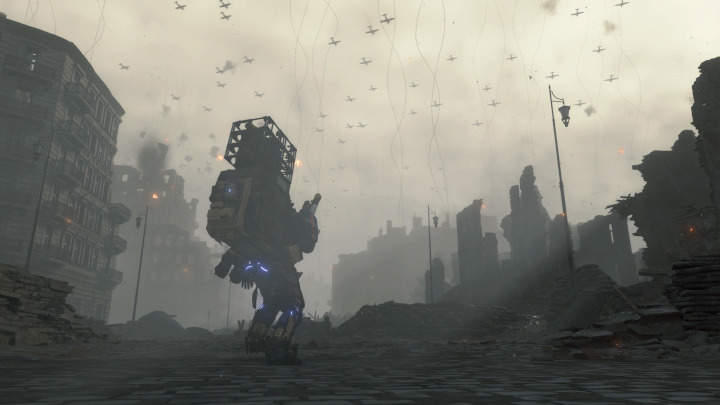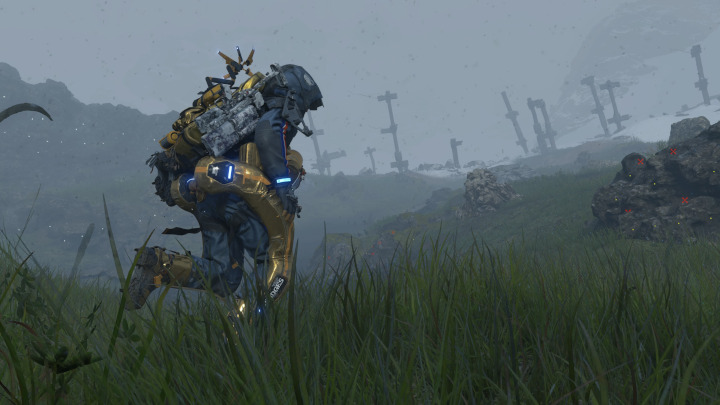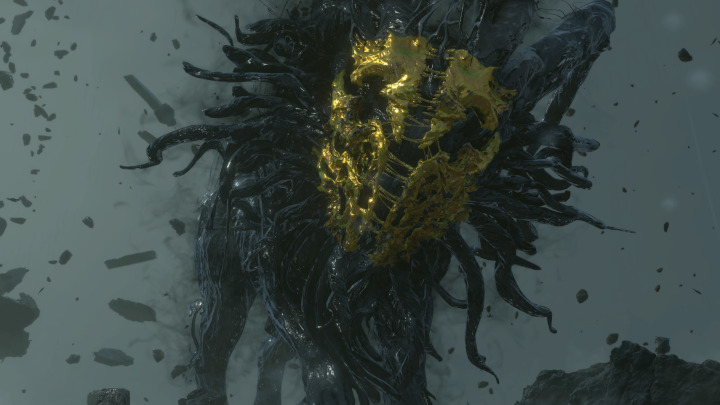
Death Stranding is such a weird little game. In fact, I think it’s safe to say that there’s really nothing else like it.
Because it’s a bit of an odd duck in the gaming sphere, it’s kind of hard to explain in a way that does it any sort of justice. People have been calling it a “post-apocalyptic mail-carrier simulator,” and I guess that’s kind of accurate, but it doesn’t really get to the unapologetic weirdness that’s at the game’s core.
This is a game in which you strap a baby to your chest so that you can see ethereal monsters called BTs (short for “Beached Things”) that are sort of caught between the worlds of the living and the dead. It’s a game that has you delivering packages to Conan O’Brien so you can acquire an otter suit that makes you swim just a little bit better. It’s a game that features timefall rain that causes anything it touches to age rapidly. This is a game in which you’ll suddenly end up in the middle of the World Wars in some sort of time-defying crowdsourced afterlife. It’s a game in which Guillermo del Toro will relentlessly chase you into the shower for awkward conversations. It’s a game that’s perfectly comfortable naming a character Die Hardman.
But yes, mechanically it’s a post-apocalyptic mail-carrier simulator.
Death Stranding first came out in 2019, and reception was pretty mixed. In fact, I found myself under its spell for a bit, and then the spell lifted and I lost interest completely. I made it to the end of Episode 5 before I called it quits. I even wrote a piece claiming I would probably never pick it back up.

But Death Stranding Director’s Cut came out this September, and it pulled me back in with its $10 price tag (to be clear, it’s $10 to upgrade from the PS4 version to the PS5 Director’s Cut, not for the base game). I’ve been playing this obsessively for two weeks now, and I have to say that my feelings for the game have changed quite a bit over the past two years.
I’ve tried to explain some of the concepts in the game earlier, but I think the best way to describe the actual experience of playing the game is that it feels immediately compelling, and then it starts trying to push you away. You’re captivated by this bizarre and kind of darkly beautiful game world as bewitching songs by Low Roar play, and then you’re forced to carry a corpse up a mountainside, where even the tiniest of pebbles will make you stumble. So the game is compelling and off-putting at the same time.
But the game’s brilliance is that it manages the tension between push and pull. It gives you a seemingly insurmountable challenge, forces you to endure no small amount of tedium, then rewards you with “Likes,” which is an ever-upward-ticking scoreboard that has no actual function in the game besides letting you know how well you’re doing.
It doesn’t end there. The game then usually gives you a tool that will let you conquer the same challenge with ease later on. You’ll stumble over streams, carefully scanning them to make sure they’re not too deep to cross, then you’ll unlock a buildable bridge. You’ll be forced to carry a ludicrously large and heavy batch of cargo across the map, then you’ll unlock a van. You’ll climb a precarious mountainside, then you’ll unlock a zip-line. You’ll tediously trudge through waist-deep snow, then you’ll unlock a skeleton suit that lets you move more quickly through that snow. The game throws these relentlessly grueling challenges at you, then it gives you exactly what you need to reduce that challenge to insignificance.

This is a balancing act that Death Stranding pulls off exceptionally well.
I think that in 2019, when I first attempted to play it, it pushed me harder than it pulled. But in 2021, I think the Director’s Cut got the balance exactly right. And that balance was really close to being perfect in the original version, but I think it erred ever-so-slightly on the side of push. The Director’s Cut gives players a few extra tools that reduce that push just a little bit.
For example, you can now unlock the brand-new Maser Gun toward the beginning of the game. This gives you a ranged option for dealing with MULEs, which are gangs of cargo-stealing human baddies. In the original version of the game, you had to fend them off with melee attacks or simply run and hide (until the game would later reward you with the Bola Gun). And considering the melee combat has been improved, these early encounters were already not as frustrating as they could be in the original. The Maser Gun gives you the upper hand in your MULE battles that makes the early part of the game feel smoother.
The Director’s Cut also includes unlockable gadgets that were initially exclusive to the PC version of the game. There were items from Half-Life (such as the Gravity Gloves, which let you pick up cargo from a short distance away) and Cyberpunk 2077 (which grant you the ability to hack MULE tech). While some of these items are just cosmetic (like the “Johnny” sunglasses and the Half-Life van), there are items that serve a gameplay function (such as the ones I mentioned earlier). This further reduces the heft of the off-putting elements of the game to swing the balance toward the pull.
These are admittedly small quality-of-life upgrades, but the game didn’t need all that much to tip the scales. As I said earlier, it was oh-so-close to getting the balance right on the first try. In the second try, the Director’s Cut fine-tunes that balance to perfection.

If you, like me, were captivated by Death Stranding back in 2019 but felt like it pushed you away just a little too hard, you really owe it to yourself to give it a second look. Death Stranding Director’s Cut makes some really small but really smart changes that offer a much more refined experience.
And yeah, all that Hideo Kojima weirdness is still intact. It just goes down more smoothly now that its few rough edges have been sanded down.